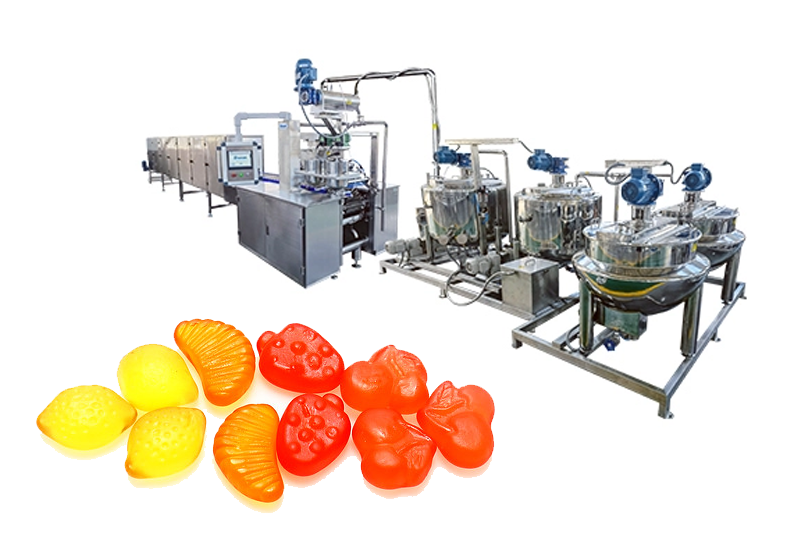Pharmaceutical industries utilize gummy machines to generate gummy items ranging from traditional candy to sophisticated medicines and supplements. In contrast to tablets, capsules, and soft gels, gummies provide a sweet and chewable alternative that many customers find more convenient and appetizing.
As with many other medicinal goods, the mass production of gummies requires specialized equipment and apparatus. This includes components such as a cooking machine, depositor, high-quality molds, and cooling equipment, as well as solutions for finishing and packing.

Gummy Ingredients
Typical materials used to create gummies are as follows:
Gelatin Or Pectin
Gelatin is the most common basic ingredient for gummy candies and is responsible for their soft, chewy, yet solid “gel” consistency. Some manufacturers may offer a vegan option for a gelling agent by using a substitute obtained from non-animal sources. The most prevalent vegan substitute is pectin, which has a somewhat softer texture than gelatin.
Water
Water is an additional common base component for candies. It prevents the gummies from drying out and keeps them moist and chewable. To maintain shelf life and prevent premature expiration, it is vital, however, to balance water activity levels.
Sweeteners
Sugar or a low-calorie sweetener provides gummy candies with their delicious flavor. Other options, such as stevia and monk fruit, can assist lower the carbohydrate load, although their melting points differ from those of sugar.
Dyes And Flavorings
Colorants and flavorings are optional but can enhance the flavor and look of a gummy product. Gummies can be manufactured in a variety of colors and flavors or a single type.
Citric Acid
Citric acid is crucial to regulating the pH of the gummy mixture. This ensures a stable mixture that retains its qualities throughout the life of the product.
Coating
Gummy coatings can improve the flavor, texture, and visual appeal of gummies. These are entirely optional, although many manufacturers include them nevertheless. Sugar granules and tapioca starch are two popular coating ingredients.
Active Ingredients
Unlike candy, gummy vitamins and supplements will contain an active substance that provides a therapeutic or medicinal effect. Although these additives are theoretically optional, they are essential for distinguishing medicinal items from candy.
How Gummy Machines Work
In a pharmaceutical production facility, product units are mass-produced using gooey machines. They are intended for the generation of big batches at once, where they are mixed, laid, and dried.
Depending on the capacity of the equipment, this number can easily surpass hundreds of thousands.
The Gummy Manufacturing Process
Cooking, depositing and cooling, and coating and quality control are the three processes of the gummy manufacturing process.
Primary Stage: Prepare
All gummies begin in the cooking step, whether they are sweets or medicines. The ingredients are placed in a prepared pot and cooked to the appropriate temperature.
The final qualities of the gummies are directly affected by the kettle’s temperature parameters. Be sure to double-check your settings before beginning the cooking process to verify that the result fits your intentions.
The liquid mixture produced by cooking the components in the kettle is known as a slurry. Once the slurry achieves the desired temperature, it is withdrawn and transferred to a mixing tank, where it is held before being deposited into molds. Other components, including citric acid, color, flavor, and active substances, are added during this process.
Second Phase: Depositing And Cooling
The slurry is passed through heated pipes following the completion of cooking. It reaches a hopper attached to the depositor, where a precise portion of the slurry will be deposited into the molds, which have been pre-chilled and treated with oil to prevent sticking.
After this portion of the second step has been completed, the molds are sent through a chilling tunnel to rapidly cool the product and set it before the gummies are expelled from the molds and placed on drying trays.
Third Phase: Coating And Quality Control
As the gummies dry, manufacturers have the option of applying a coating with a gummy coating machine. If not, quality control is initiated. This essential last step guarantees that the gummies are in the appropriate condition for packaging and distribution to retail outlets.
Multiple stages, such as validating bottle counts and ingredient standards, might be involved in quality control. Using a water activity meter to accurately measure the water’s activity level is the most crucial factor.
In a variety of ways, excessive or insufficient water activity can taint a product. These include an unpleasant texture, an early expiration date, or microbial development.
Get The Industry’s Leading Gummy Machines For Your Facility
Kosbest is the industry leader in gummy machine production, with a full line of machines that are ready to be installed in your facility. Our products are perfect for any type of facility, from small-scale candy shops to large-scale manufacturing plants. They’re easy to use, easy to clean and maintain, and will save you money—but most importantly, they’ll help you produce high-quality gummies at a consistent rate.
 One-Stop Solution Manufacturer of Gummy Making Machine
One-Stop Solution Manufacturer of Gummy Making Machine